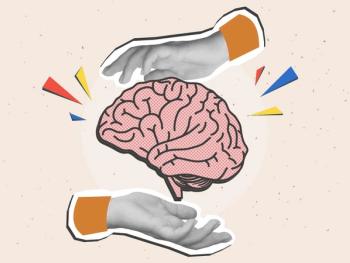
- Vol 33 No 4
- Volume 33
- Issue 4
Top-down Plus Bottom-up Integrative Treatments in Psychiatry
Top-down approaches, in which the mind of the therapist engages the mind of the patient, have dominated traditional psychotherapy and psychoanalysis. However, the effects of mind-body approaches on cognitive and emotional processes show that integrating bottom-up with top-down modalities can be highly effective-even in acute or chronic severe treatment-resistant conditions, such as trauma- and stressor-related disorders.1 Multimodal and integrative treatments have been found to rapidly reduce symptoms of anxiety, depression, and PTSD in numerous studies.2 Furthermore, with 20 minutes of practice 5 days per week, the improvements persist at long-term follow-up.
Mind-body interventions and stress
In a world that is straining our stress response systems with pressure, trauma, uncertainty, and threats, the autonomic system spends too much time in the fight/flight zone. The tide of distress and dysfunction, which is overwhelming health care systems, will not be stopped by medications alone, nor by one-on-one therapies or expensive high-tech treatments.
Mind-body interventions that are less costly and low-risk can provide long-term symptomatic relief to large populations, including survivors of natural and man-made disasters.3 Identifying best practices for prevention and treatment of stress-related disorders could substantially benefit public health. Improvements in technology-for example, measures of heart rate variability-provide ways to evaluate and enhance the effects of mind-body interventions on stress response.
Voluntarily regulated breathing practices
Mind-body practices include movement, breathing, and meditation. According to polyvagal theory, states that are characterized by increased influence of the parasympathetic myelinated pathways of the vagal nerves increase feelings of safety and support social engagement and bonding while inhibiting defense limbic system reactions.4 Within minutes, slow, voluntarily regulated breathing practices (VRBPs)-in the range of 4.5 to 6 breaths per minute for most adults-will lead to a state of sympatho-vagal balance characterized by emotional calmness and mental alertness.5 This state improves emotional processing, cognitive functioning, and the capacity for positive relationships.
Respiration is the only autonomic function that can be easily changed through voluntary effort. The voluntary control of breathing provides a portal for interoceptive communication between the body and the brain. Interoception is the perception of sensations or other signals that carry information about the internal state of the body.6
Through “interoceptive messaging” of signals from the respiratory system, VRBPs can induce rapid, widespread effects on emotional states; perceptions; subjective experience of the body; cognitive processes; and the capacity for social engagement, connectedness, bonding, empathy, and love.7,8
Simple VRBPs can be easily integrated into psychotherapy and mindfulness or cognitive therapies. Such practices can be adapted for individual or group interventions in clinics, hospitals, schools, and after-school programs. Further information on the use of VRBPs can be found at
This article was originally posted on 2/8/2016 and has since been updated.
Disclosures:
Dr Gerbarg is Assistant Clinical Professor of Psychiatry at New York Medical College in Valhalla, NY. Dr Brown is Associate Clinical Professor of Psychiatry at Columbia University Medical Center in New York. Both Dr Gerbarg and Dr Brown are members of the Caucus on Complementary and Integrative Treatments of the American Psychiatric Association (APA). They have co-authored articles and award-winning books and have provided courses on complementary and integrative medicine at APA meetings.
References:
1. Gard T, Noggle, JJ, Park CL, et al. Potential self-regulatory mechanisms of yoga for psychological health. Front Hum Neurosci. 2014;8:1-20.
2. Brown RP, Gerbarg PL, Muench F. Breathing practices for treatment of psychiatric and stress-related medical conditions. Psychiatr Clin North Am. 2013; 36:121-140.
3. Gerbarg PL, Wallace G, Brown RP. Mass disasters and mind-body solutions: evidence and field insights. Int J Yoga Therapy. 2011;2:23-34.
4. Porges SW. The polyvagal theory: new insights into adaptive reactions of the autonomic nervous system. Cleve Clin J Med. 2009;76(suppl 2):S86-S90.
5. Brown RP, Gerbarg PL. The Healing Power of Breath [book and CD-ROM]. New York: Shambhala Press; 2012.
6. Craig AD. Interoception and emotion: a neuroanatomical perspective. In: Lewis M, Haviland-Jones JM, Feldman Barrett L, eds. Handbook of Emotions. New York: Guilford Press; 2008:272-290.
7. Gerbarg PL, Brown RP. Yoga and neuronal pathways to enhance stress response, emotion regulation, bonding, and spirituality. In: Horowitz EG, Elgelid S, eds. Yoga Therapy: Theory and Practice. New York: Routledge Taylor and Francis Group; 2015:49-64.
8. Streeter CC, Gerbarg PL, Saper MD, et al. Effects of yoga on the autonomic nervous system, gamma-aminobutyric-acid, and allostasis in epilepsy, depression, and post-traumatic stress disorder. Med Hypotheses. 2012;78:571-579.
Articles in this issue
over 9 years ago
Extracurricular Activities for Early-Career Psychiatristsover 9 years ago
Introduction: Working With Patients Who Have Eating Disordersover 9 years ago
Neurobiology of Eating Disorders: Clinical Implicationsover 9 years ago
Eating Disorders and Psychosisover 9 years ago
Cyberbullying and College Students: What Can Be Done?over 9 years ago
Addiction Psychiatry: Laws, Guidelines, and Suggestionsover 9 years ago
Update on Treatment of Pediatric Bipolar DisorderNewsletter
Receive trusted psychiatric news, expert analysis, and clinical insights — subscribe today to support your practice and your patients.














